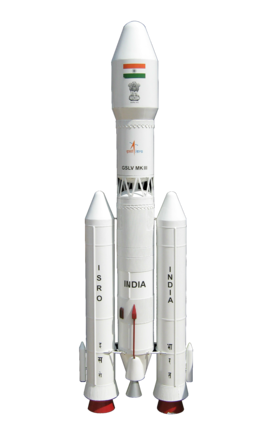Geosynchronous Satellite Launch Vehicle Mk III

An artist's rendering of the Geosynchronous Satellite Launch Vehicle Mk III.
|
|
| Function | Medium-lift launch vehicle |
|---|---|
| Manufacturer | Indian Space Research Organisation |
| Country of origin | India |
| Size | |
| Height | 43.43 m (142.5 ft) |
| Diameter | 4.0 m (13.1 ft) |
| Mass | 640,000 kg (1,410,000 lb) |
| Stages | 3 |
| Capacity | |
| Payload to LEO (600 km) | 8,000 kg (18,000 lb) |
| Payload to GTO | 4,000 kg (8,800 lb) |
| Launch history | |
| Status | Development |
| Launch sites | Satish Dhawan Space Centre SLP, Andhra Pradesh, India |
| Total launches | 1 (2 stage version) |
| Successes | 1 (2 stage version) |
| First flight | 18 December 2014 (2 stage version; sub-orbital flight) |
| Notable payloads | Crew Module Atmospheric Re-entry Experiment |
| Boosters - S200 | |
| No. boosters | 2 |
| Length | 25 m (82 ft) |
| Diameter | 3.2 m (10 ft) |
| Propellant mass | 207,000 kg (456,000 lb) |
| Motor | Solid S200 |
| Thrust | 5,150 kN (525 tf) each |
| Specific impulse | 274.5 (vacuum) |
| Burn time | 130 sec |
| Fuel | HTPB |
| Core stage - L110 | |
| Length | 17 m (56 ft) |
| Diameter | 4.0 m (13.1 ft) |
| Propellant mass | 110,000 kg (240,000 lb) |
| Engines | 2 Vikas engines |
| Thrust | 1,598 kN (163.0 tf) |
| Specific impulse | 293 sec |
| Burn time | 200 sec |
| Fuel | UDMH/N2O4 |
| Upper stage - C25 | |
| Length | 13.5 m (44 ft) |
| Diameter | 4.0 m (13.1 ft) |
| Propellant mass | 27,000 kg (60,000 lb) |
| Engines | 1 CE-20 |
| Thrust | 200 kN (20 tf) |
| Specific impulse | 443 sec |
| Burn time | 586 sec |
| Fuel | LOX/LH2 |
The Geosynchronous Satellite Launch Vehicle Mark III (Hindi: भूस्थिर उपग्रह प्रक्षेपण यान एमके-३; IAST: Bhūsthir Upagrah Prakșepaņ Yān MK-3, also referred to as the Launch Vehicle Mark 3, LVM3 or GSLV-III) is a launch vehicle developed by the Indian Space Research Organisation (ISRO).
It is intended to launch satellites into geostationary orbit and as a launcher for an Indian crew vehicle. The GSLV-III features an Indian cryogenic third stage and a higher payload capacity than the current GSLV.
Development for the GSLV-III began in the early 2000s, with the first launch planned for 2009-2010. Several factors have delayed the program, including the 15 April 2010 failure of the ISRO-developed cryogenic upper stage on the GSLV Mk II.
A suborbital flight test of the GSLV-III launcher, with a passive cryogenic third stage, was successfully carried out on 18 December 2014, and was used to test a crew module on a suborbital trajectory. The first orbital flight is planned to take place in 2017. The first flight with a crew on board would take place after 2020.
The S-200 solid rocket booster was successfully tested on 24 January 2010. The booster fired for 130 seconds and generated a peak thrust of about 500 tonnes. Nearly 600 ballistic and safety parameters were monitored during the test and indicated normal performance. A second successful static test was conducted on 4 September 2011.
The Indian Space Research Organisation conducted the first static test of the L110 core stage at its Liquid Propulsion Systems Centre (LPSC) test facility at Mahendragiri, Tamil Nadu on 5 March 2010. Originally targeted for a full 200 second burn, the test was terminated at 150 seconds after a leakage in a control system was detected. On 8 September 2010 ISRO successfully conducted a full 200 second test.
...
Wikipedia
